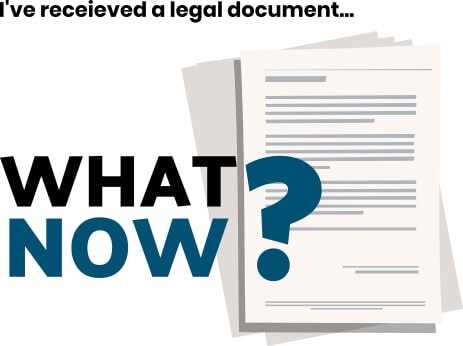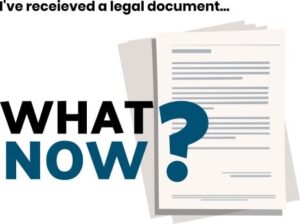When there is concern over the dissipation of company assets before the winding up hearing, the application for winding up may also be accompanied by an application to appoint provisional liquidators. This application is seeking an order from the court that a liquidator be appointed provisionally to exercise interim control of the company’s assets and affairs pending the final winding up hearing. The appointment is “provisional” because the company may not be wound up at the winding up hearing, in which case control of the company may return to its directors.
Because the application to appoint provisional liquidators is an urgent interim measure, the hearing for the appointment of provisional liquidators is usually scheduled at very short notice to the company upon which it is served. You should therefore immediately upon receipt determine the hearing date, time and place.
This is a very serious matter requiring your immediate attention.
If you do not arrange to be represented at the hearing, there is every likelihood that the court will order that your company be placed under the control of provisional liquidators on that date.
It is therefore imperative that you urgently seek professional advice.
Applications for appointment of a provisional liquidator are presented in Australia under section 472(2) of the Corporations Act 2001 (Cth) (the Act).
An application to appoint provisional liquidators may be filed any time after the filing of a winding up application and before the making of a winding up order, or any decision on an appeal against the making of a winding up order.
The application may be brought by company creditors or members of the company itself. The onus is on the applicants to show a good ground for winding up the company based on the winding up application, and that it is in the interest of the company’s creditors or members, or in the public interest for the court to exercise its discretion and appoint provisional liquidators (Re McLennan Holdings Pty Ltd (1983) 7 ACLR 732 at 738).
An application to appoint provisional liquidators may, in the case of the urgent need to protect company assets at risk, be made “ex parte” or without notice to any other interested parties, provided the applicant makes full and frank disclosure of all relevant matters to the court (Re Branchport Pty Ltd [2004] FCA 1015). Failure to make the application on notice to any of the other parties interested in the outcome will run the risk of the order to appoint provisional liquidators being revoked.
Filing an application to appoint of provisional liquidators means filing a Form 3 Interlocutory Application, with evidence by affidavit to support it, in the Supreme Court, under rule 2.2(4) of Schedule 1A to the Uniform Civil Procedure Rules 1999 (Qld) (UCPR). Upon filing, the court allocates a hearing date for the application to be heard, endorses this on the application, and returns the documents to the applicant to arrange service on the company and any other interested parties.
Service of the application to appoint provisional liquidators usually occurs by sending the application and the supporting affidavits by prepaid post to the registered office of the company (section 109X(1)(a) of the Act). However, in cases of extreme urgency to protect company assets, service by other more immediate means such as email, courier or personal service on directors may be allowed at the court’s discretion.
Once the application has been served, the hearing of the application can proceed on the hearing date. If the company or its directors do not arrange to be represented at the hearing, the court will order that the company be placed under the control of the provisional liquidators designated in the application provided they consider that the requirements under the Act have been met. A registered liquidator (who has given their consent and is not subject to any conflict of interest) may be appointed as provisional liquidator of the company.
Once appointed the provisional liquidators will take control of the company and ensure that the company’s divisible assets are preserved for distribution amongst its creditors in the event a winding up order is ultimately made.
The alternative to failing to attend the hearing of the application to appoint provisional liquidators, is for the company to arrange to be represented at the hearing and to oppose the application. If the company intends to do this, it must file a Form 4 Notice of Appearance and a supporting affidavit under rule 2.9(1)(a) of Schedule 1A UCPR and serve that on the applicant at least one day before the hearing (rule 2.9(1)(b)(ii)). Common grounds relied on to oppose the application are:
- the amount claimed in the winding up application is not owed by the company because no debt was owed to the applicant creditor, the debt was paid, or the judgment relied on is being set aside, and establishing this is material to proving the company is solvent;
- the company is able to rebut any presumption of insolvency relied on because it can pay its debts and is not insolvent;
- the company is able to prove it is solvent and there is a genuine dispute about the debt claimed;
- there is a defect in the material or non-compliance with the procedures required to obtain a winding up order; and
- there are no assets of the company at risk of dissipation sufficient to justify appointing a provisional liquidator.
If the company’s opposition to the application is successful, the application may be dismissed by the court.
Important considerations
Because failure to respond to an application to appoint provisional liquidators has such serious consequences for your company, the applicant making the application must have strictly complied with all legal formalities under the Act for filing and serving the application, and to meet the requirements for appointing a provisional liquidator. Some of these considerations are set out below.
How was the application served?
How your company received the application is extremely important. You should make a note of how and when your company received it and keep copies of all documents and written communications you received with it.
Are the applicant’s details correct?
Do you know the person or company who has sent your company the application? Compare the details on the application with previous documents you have received from them. Do they make sense or is there some confusion?
Are your company’s details correct?
Has the person or company who sent your company the application correctly described your details in the application? This is very important; particularly in relation to your company’s name and Australian Company Number (ACN).
Were you aware there was a judgment or creditor’s statutory demand issued against your company?
The documents accompanying the application for winding up which preceded the application to appoint provisional liquidators will include a copy of the creditor’s statutory demand and the judgment relied on. The judgment will have a court heading on it describing the court it was issued from, a claim number, and the parties concerned with that claim. Are you familiar with those court proceedings, or is that the first time you became aware of them? Is this the first time you saw the creditor’s statutory demand? If not, what were the circumstances in which your company received it?
Does your company owe the applicant money?
If you are not familiar with the court proceedings or judgment, check your company’s records to see if you have ever had any contact with the person or company who issued the application for winding up and the creditor’s statutory demand. Situations have arisen where the wrong company has been sued for a debt because they have a similar name or ACN to the actual debtor.
If your company has dealt with the applicant before, according to your own records and understanding, did your company still owe them any money? If there was a balance owing to the applicant, was there another reason your company had not paid it? Did they owe your company a similar or larger amount of money?
Is the amount claimed overstated?
Check your company’s records to confirm whether the amount being claimed by the applicant in their judgment for the claim amount is the same as the balance you thought was owing. Has the applicant claimed in excess of what you thought was owing?
Your company may have these options
As you can see, there are many important considerations to be examined before deciding how to respond to an application to appoint provisional liquidators and the accompanying application for winding up. Investigating these considerations and gathering information to identify any errors in the applications takes time. We therefore urge you to consider those matters as soon as possible as they will determine your company’s options to respond to these applications.
In broad terms, your company’s options are:
- to pay the amount claimed in the application for winding up before the hearing;
- to arrange with the applicant who filed the applications to pay off the amount claimed and adjourn the hearings while that occurs;
- to apply to the court to adjourn the hearing of the applications; or
- to apply to the court to dismiss the applications.
If the information in the application for winding up is completely accurate, the first two options are the appropriate ones for you to consider. If your company does not have the financial means to pay the full amount claimed, and the applicant will not agree to an informal arrangement to settle that amount, several formal options may be available to your company under the Act to achieve that outcome. The Act has “safe harbour” provisions, the voluntary administration process and trading through corporate cashflow difficulties under a deed of company arrangement as options that may avoid your company being placed into liquidation, or provisional liquidation.
It may well be that your company intends opposing the applications on some of the grounds described above but requires more time to prepare its case. It may also need more time to negotiate an outcome with the applicant or is awaiting the outcome of court proceedings related to the applicant’s debt. In those situations, your company may be able to obtain an adjournment of the hearing date from the court. An application for an adjournment will need to be supported by affidavit evidence prepared by a lawyer experienced in insolvency law. If this is not done correctly and an adjournment is refused, your company could be placed into provisional liquidation or subsequently wound up at the first hearing date.
Similarly, if your company intends opposing the applications on any of the grounds set out above, it is essential that your company engages an experienced insolvency lawyer to help have the applications dismissed.
The most persuasive ground a company can rely on to have an application for winding up dismissed is to prove to the court that it is solvent. Liquidation is a legal process for the administration and winding up of a company’s affairs. Therefore, if your company wishes to continue to trade and is not insolvent, this needs to be demonstrated to the court. Proof of solvency is a consideration which equally applies to successfully resisting an application to appoint provisional liquidators.
Balance sheet solvency is not enough, i.e. an excess of assets over liabilities. The test of solvency is for a company to be able to demonstrate that it is able to pay its debts as and when they fall due. Sufficient assets to cover those debts may not be enough to prove solvency to a court if those assets cannot be readily sold to pay creditors. To prove solvency the court needs to be shown, by affidavit evidence, all relevant material with respect to the company’s financial affairs so that it can make its judgment based on the actual facts and circumstances of the company’s financial position.
Insolvency is a technical and complex area of law and you should seriously consider obtaining legal advice if you believe that there may be grounds for your company to oppose the applications your company has been served with. Doing this may well be the difference between achieving a just outcome for your company and its members and orders being made against it placing it into liquidation, or provisional liquidation.
If you have recently received an application to appoint provisional liquidators and need help to to urgently assess its ramifications for your company, one of our experienced team of solicitors will be happy to help you. Contact Gibbs Wright Litigation Lawyers today for a confidential initial consultation to explore your options and legal rights.




